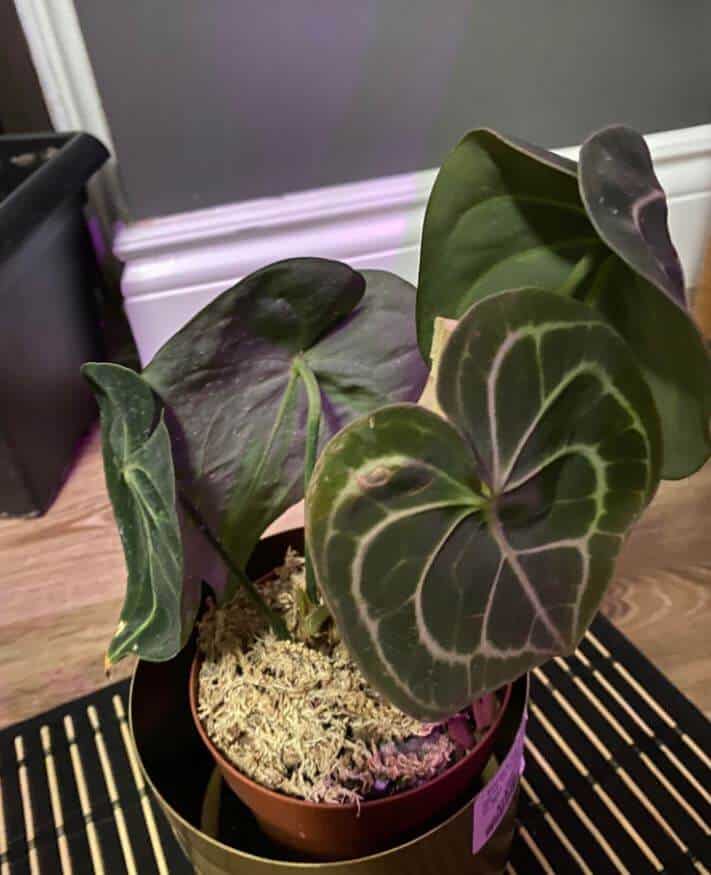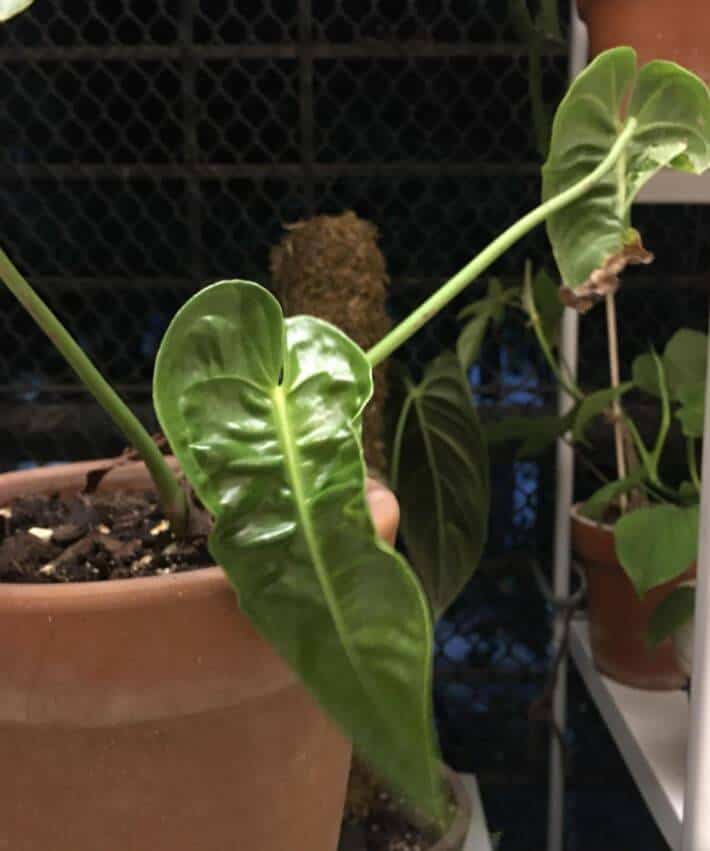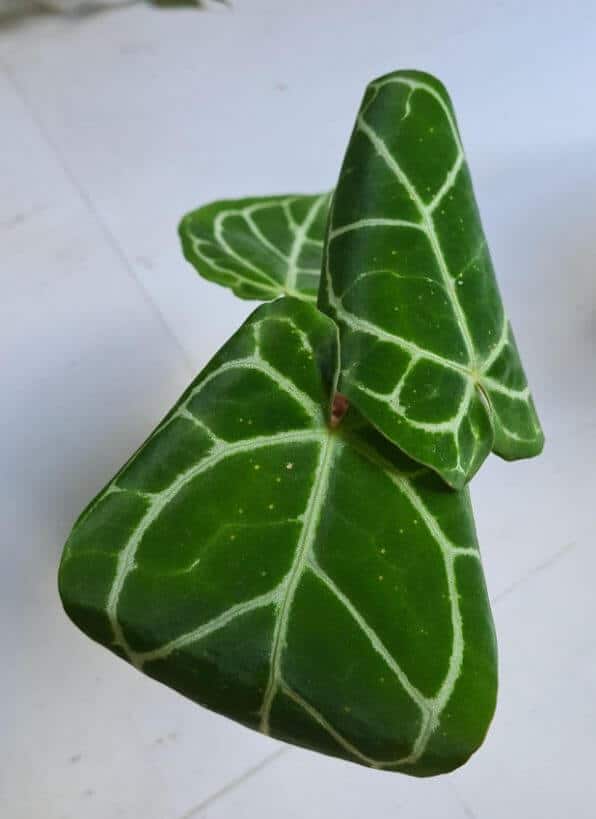Last Updated on August 7, 2023 by a Friendly Gardener
The genus Anthurium contains approximately 1,000 perennials that find their native habitats in the Caribbean, Central, and South America. Cultivated as lovely colorful plants in outdoor gardens where warm climates are the norm, they also make an incredibly popular indoor houseplant. The growth rate is slow but they can bloom year-round. Often referred to as Flamingo flowers for their red, white, green, and coral hues, they feature heart-shaped spathes with colorful flower spikes. Members of the Araceae family, some species are climbers.
Why Are My Anthurium Leaves Curling?

Anthuriums are very communicative and will let you know if their care is not exactly right. Foliage will show when the plant is stressed from overwatering, underwatering, inadequate humidity, or other.
Anthurium curling leaves can be due to improper soil, light, water, environmental temperatures, humidity levels, feeding issues, and pest infestations and infections. New foliage may begin life curling because the container size is incorrect. The principal challenge is identifying the cause to correct your care routine as any of these reasons can trigger leaf curling.
Reasons for Anthurium Leaves Curling

Improper soil
One of the most common causes of Anthurium leaf curling is the soil mix. These plants require soil that is loose and well-draining. To keep your plant happy, the potting soil mix might include perlite, orchid bark, peat moss or coco coir, and some charcoal. Drainage prevents root rot. This kind of soil mix will create air pockets within the growing medium so that root systems are adequately aerated.
What to do
If you think the soil may be to blame, acquire a potting soil mix for aroids.
Overwatering and Root Rot
Anthuriums rarely need to be watered more than once weekly, and in any case, you need to check the soil. When the soil surface is dry to about an inch deep, it’s time to water. When potting soil feels damp, do not water it! Soggy soil can lead to yellowing and curling leaves.
What to do
If you have overwatered, take the anthurium out of its pot and check the root system for signs of root rot such as mushy, dark, or smelly roots. All infected root parts need to be trimmed off. Rinse the remaining healthy roots. Sterilize your container and repot your plant in fresh potting mix.
Underwatering
Anthurium leaves curling can also be a sign of insufficient watering. While this is less common as an issue, occasionally anthuriums are underwatered. Leaves may curl to reduce moisture needs and eventually turn brown.
What to do
Increase your watering schedule to once weekly. Water deeply until excess water drains from the container’s drainage holes. Try to maintain the growing medium slightly humid.
Low Humidity Levels

Anthuriums relish high humidity. They prefer 70% to 80% in their growing habitat. They can survive with 50% but they will not flourish.
What to do
If you have doubts, measure the room’s humidity level. Place your anthurium in a bathroom or kitchen when levels are generally higher. Use a small space humidifier to help your plant or introduce a pebble tray beneath the plant’s container. Avoid misting an Anthurium as this can lead to bacterial infections if the leaves remain wet for too long.
Improper Environmental Light
Many anthurium species grow best when kept in a spot with generous, bright, but indirect sunlight. If you place your Anthurium in direct sunlight, there is a good chance that foliage will scorch, causing leaves to curl, wilt, and turn brown.
Too little sunlight is equally risky, as your plant will not have sufficient light for photosynthesis and nourishment.
What to do
Find a spot for your plant in or near an eastern or western-facing window. Do not place the plant too close to the window glass as foliage is sensitive.
Improper Environmental Temperatures

When environmental temperatures are too cold or too hot, your plant will become stressed. Anthuriums do best when temperatures measure in the 75° to 92° F. range. These plants are also highly sensitive to sudden temperature fluctuations whether a drop or an increase.
What to do
Keep your plant away from heating and air conditioning units or anything or location that can expose it to drafts. Also, keep it several inches from a windowpane in the summer to protect it from excessive heat and in the winter to protect it from the cold.
Improper Feeding
Anthuriums can do with a bit of fertilizing during the growing season in spring and summer. A monthly dose of a liquid fertilizer that has an NPK ratio of 10-10-10 or 20-20-20 at the most is best. Avoid overfeeding by following the manufacturer’s recommended dose. If you prefer to fertilize safely, dilute your fertilizer to half or a third of the recommended strength. Overfertilization can cause foliage to curl.
A lack of fertilization can be just as stressful as your plant may lack the essential nutrients for its health. Nitrogen, phosphorous, and potassium (NPK) must be provided along with Manganese, Iron, Zinc, Boron, and Copper.
What to do
If you have overfed your Anthurium, you will need to flush out the soil bed as the fertilizer can or may be burning the roots. Flush out the soil bed with tepid running water to remove excess salt buildup in the soil from fertilizers.
If underfeeding is the cause, schedule a monthly feeding during the growing season.
Water Quality
The quality of our water supplies varies depending on where you reside. In heavily populated metropolitan areas, fluoride and chlorine are frequent additives to municipal water supplies. These chemicals can trigger leaf curling. Some water supplies may also be hard due to the quantity of minerals contained within, and water has a pH level that can range from alkaline to acidic. The quality of the water you give your plant can affect the soil quality. Anthuriums prefer a pH measuring between 5 and 6.
What to do
To avoid quality issues, use collected rainwater where possible as it will not contain additives. If this is not possible consider using distilled water or reverse osmosis water. If this is not a possibility, leave a filled watering can or pitcher out for 12 to 24 hours to aid in the evaporation of chloramines and chlorine before watering your plant.
Pest Infestations
Pests love houseplants and Anthuriums are no exception. Thrips, spider mites, mealybugs, and scale can suck the plant’s sap and strength causing Anthurium curling leaves. Fungus gnats and whiteflies can also stress your plant. Several of these pests can also transmit disease to your plant causing stunted and distorted growth followed by leaf curling.
What to do
Examine your Anthurium weekly for signs of pest infestations. This includes checking leaf undersides as well. If you find pests on your plant, treat it and the soil surface with horticultural neem oil or insecticidal soap weekly.
A Final Consideration

If you need to repot your Anthurium, avoid doing so if the plant is blooming. Also, remember that new growth will be curled and slowly unfurl, so you may be noting new growth when observing curled leaves.

